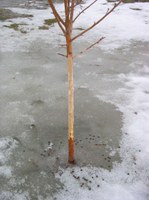Dakota Gardener: The annual report
(Click an image below to view a high-resolution image that can be downloaded)
By Joe Zeleznik, forester
NDSU Extension
I was working on my annual reports this last week, and after 20-plus years in this job, there wasn’t a whole lot that surprised me. Let’s just say that my year has its ebbs and flows.
I then got to wondering what a 20-year-old tree might write in its annual report. Or, instead of annual reports, maybe they would be diary entries. Assuming, of course, that a tree could write.
The annual report for most trees in North Dakota would be pretty boring. They grew, dealt with a bit of drought and windy weather, and perhaps faced some small pest problems. And that was about it.
Some trees had it tough. Storms came with heavy snow or ice. Extreme temperatures hit the state. Insects and diseases were at high levels in some areas.
Here are some excerpts from those imaginary diary entries:
- From a random ash tree growing on a boulevard in Moorhead, Minnesota in February 2023, “Did nothing again today – it’s winter and I’m dormant! However, employees from the city forestry department pruned some branches today. I hope they find that emerald ash borer that’s been eating me. That insect really gets under my skin!”
- From a young apple tree, growing on a farmstead in rural Emmons County, late March, “Finally breaking out of dormancy, not that it’s going to matter. Rabbits ate all the bark around the base of my stem this winter. I might grow a little this spring, but I’m on my way out. Darn!”
- From a maple tree growing in Crosby, late July, “I’m feeling anemic – low iron. Technically, it’s not anemia in trees, but rather it’s ‘iron chlorosis’. My leaves are pretty yellow, even though they’re supposed to be green. I know there’s plenty of iron in the soil, but I just can’t access it. It’s tough being a maple in North Dakota. I hear that the red oaks and the river birches are also suffering. Poor guys.”
- From an oak tree, Rugby, mid-August, “Sooooooo thirsty.”
- From a honeylocust tree growing in a well-maintained yard, Grand Forks, late September, “Wow, I’m still growing a million miles an hour. The homeowners are still watering the lawn every other day, and they fertilized four times this summer. I need to slow down! If I can’t stop growing, and harden up for winter, I’m not going to survive.”
- From a newly planted apple tree on a rural farmstead, Emmons County, October, “Just about finished hardening up for winter. Looking forward to dormancy. Grateful that the landowners put some protection around my stem – white plastic corrugated pipe. I’ve heard that those jackrabbits are nasty during the winter.”
Okay, so these really aren’t journal entries and trees don’t write annual reports. Nevertheless, these are some of the real issues that we’ve seen in 2023. In fact, we see most of these issues every year, at one or more locations in the state. Trees experience good conditions and bad, and people make good management decisions and poor ones. Hopefully, we’ll make better choices with our trees next year.
Here’s a really bad pun – because trees are long-lived, I don’t think they would write annual reports. They would write perennial reports.
NDSU Agriculture Communication – Oct. 18, 2023
Source: Joe Zeleznik, 701-730-3389, joseph.zeleznik@ndsu.edu
Editor: Kelli Anderson, 701-231-7881, kelli.c.anderson@ndsu.edu




